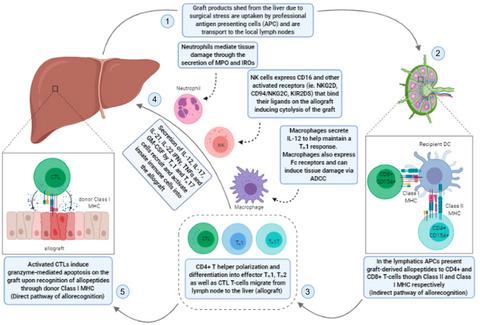当前位置:
X-MOL 学术
›
Clin. Exp. Immunol.
›
论文详情
Our official English website, www.x-mol.net, welcomes your
feedback! (Note: you will need to create a separate account there.)
Identification of peripheral CD154+ T cells and HLA‐DRB1 as biomarkers of acute cellular rejection in adult liver transplant recipients
Clinical & Experimental Immunology ( IF 3.4 ) Pub Date : 2020-10-06 , DOI: 10.1111/cei.13533 F Boix 1 , I Legaz 2 , A Minhas 3 , R Alfaro 4 , V Jiménez-Coll 4 , A Mrowiec 4 , H Martínez-Banaclocha 4 , J A Galián 4 , C Botella 4 , M R Moya-Quiles 4 , F Sanchez-Bueno 5 , R Robles 5 , J de la Peña-Moral 6 , P Ramirez 5 , J A Pons 7 , A Minguela 4 , M Muro 4
Clinical & Experimental Immunology ( IF 3.4 ) Pub Date : 2020-10-06 , DOI: 10.1111/cei.13533 F Boix 1 , I Legaz 2 , A Minhas 3 , R Alfaro 4 , V Jiménez-Coll 4 , A Mrowiec 4 , H Martínez-Banaclocha 4 , J A Galián 4 , C Botella 4 , M R Moya-Quiles 4 , F Sanchez-Bueno 5 , R Robles 5 , J de la Peña-Moral 6 , P Ramirez 5 , J A Pons 7 , A Minguela 4 , M Muro 4
Affiliation

|
Decreasing graft rejection and increasing graft and patient survival are great challenges facing liver transplantation (LT). Different T cell subsets participate in the acute cellular rejection (ACR) of the allograft. Cell‐mediated immunity markers of the recipient could help to understand the mechanisms underlying acute rejection. This study aimed to analyse different surface antigens on T cells in a cohort of adult liver patients undergoing LT to determine the influence on ACR using multi‐parametric flow cytometry functional assay. Thirty patients were monitored at baseline and during 1 year post‐transplant. Two groups were established, with (ACR) and without (NACR) acute cellular rejection. Leukocyte, total lymphocyte, percentages of CD4+CD154+ and CD8+CD154+ T cells, human leukocyte antigen (HLA) mismatch between recipient–donor and their relation with ACR as well as the acute rejection frequencies were analysed. T cells were stimulated with concanavalin A (Con‐A) and surface antigens were analysed by fluorescence activated cell sorter (FACS) analysis. A high percentage of CD4+CD154+ T cells (P = 0·001) and a low percentage of CD8+CD154+ T cells (P = 0·002) at baseline were statistically significant in ACR. A receiver operating characteristic analysis determined the cut‐off values capable to stratify patients at high risk of ACR with high sensitivity and specificity for CD4+CD154+ (P = 0·001) and CD8+CD154+ T cells (P = 0·002). In logistic regression analysis, CD4+CD154+, CD8+CD154+ and HLA mismatch were confirmed as independent risk factors to ACR. Post‐transplant percentages of both T cell subsets were significantly higher in ACR, despite variations compared to pretransplant. These findings support the selection of candidates for LT based on the pretransplant percentages of CD4+CD154+ and CD8+CD154+ T cells in parallel with other transplant factors.
中文翻译:

鉴定外周 CD154+ T 细胞和 HLA-DRB1 作为成人肝移植受者急性细胞排斥的生物标志物
减少移植排斥反应并提高移植物和患者的存活率是肝移植(LT)面临的巨大挑战。不同的 T 细胞亚群参与同种异体移植物的急性细胞排斥 (ACR)。受体的细胞介导的免疫标记物有助于了解急性排斥反应的机制。本研究旨在分析接受 LT 的成年肝脏患者队列中 T 细胞上的不同表面抗原,以使用多参数流式细胞术功能测定法确定对 ACR 的影响。在基线和移植后 1 年内对 30 名患者进行了监测。建立了两组,有(ACR)和没有(NACR)急性细胞排斥反应。分析白细胞、淋巴细胞总数、CD4 + CD154 +和CD8 + CD154 + T细胞百分比、受者与供者之间人类白细胞抗原(HLA)不匹配及其与ACR的关系以及急性排斥反应频率。用刀豆球蛋白 A (Con-A) 刺激 T 细胞,并通过荧光激活细胞分选仪 (FACS) 分析表面抗原。基线时高百分比的 CD4 + CD154 + T 细胞 ( P = 0·001) 和低百分比的 CD8 + CD154 + T 细胞 ( P = 0·002) 在 ACR 中具有统计学意义。接受者操作特征分析确定了能够对 ACR 高风险患者进行分层的临界值,对 CD4 + CD154 + ( P = 0·001) 和 CD8 + CD154 + T 细胞 ( P = 0·002) 具有高敏感性和特异性)。 Logistic回归分析证实CD4 + CD154 + 、CD8 + CD154 +和HLA不匹配是ACR的独立危险因素。尽管与移植前相比存在差异,但 ACR 中两种 T 细胞亚群的移植后百分比均显着较高。这些发现支持根据移植前 CD4 + CD154 +和 CD8 + CD154 + T 细胞的百分比以及其他移植因子来选择 LT 候选者。
更新日期:2020-10-06
中文翻译:

鉴定外周 CD154+ T 细胞和 HLA-DRB1 作为成人肝移植受者急性细胞排斥的生物标志物
减少移植排斥反应并提高移植物和患者的存活率是肝移植(LT)面临的巨大挑战。不同的 T 细胞亚群参与同种异体移植物的急性细胞排斥 (ACR)。受体的细胞介导的免疫标记物有助于了解急性排斥反应的机制。本研究旨在分析接受 LT 的成年肝脏患者队列中 T 细胞上的不同表面抗原,以使用多参数流式细胞术功能测定法确定对 ACR 的影响。在基线和移植后 1 年内对 30 名患者进行了监测。建立了两组,有(ACR)和没有(NACR)急性细胞排斥反应。分析白细胞、淋巴细胞总数、CD4 + CD154 +和CD8 + CD154 + T细胞百分比、受者与供者之间人类白细胞抗原(HLA)不匹配及其与ACR的关系以及急性排斥反应频率。用刀豆球蛋白 A (Con-A) 刺激 T 细胞,并通过荧光激活细胞分选仪 (FACS) 分析表面抗原。基线时高百分比的 CD4 + CD154 + T 细胞 ( P = 0·001) 和低百分比的 CD8 + CD154 + T 细胞 ( P = 0·002) 在 ACR 中具有统计学意义。接受者操作特征分析确定了能够对 ACR 高风险患者进行分层的临界值,对 CD4 + CD154 + ( P = 0·001) 和 CD8 + CD154 + T 细胞 ( P = 0·002) 具有高敏感性和特异性)。 Logistic回归分析证实CD4 + CD154 + 、CD8 + CD154 +和HLA不匹配是ACR的独立危险因素。尽管与移植前相比存在差异,但 ACR 中两种 T 细胞亚群的移植后百分比均显着较高。这些发现支持根据移植前 CD4 + CD154 +和 CD8 + CD154 + T 细胞的百分比以及其他移植因子来选择 LT 候选者。











































 京公网安备 11010802027423号
京公网安备 11010802027423号